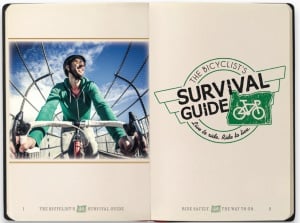
The Oregon Department of Transportation (ODOT) has just released The Bicyclist’s Survival Guide (PDF), a new publication about bicycling. Here’s how they introduce it in an official statement sent out this morning:
“Looking to get back on the bike and be part of the active transportation crowd? You’ll save money, reduce pollution and improve your health! Here is “The Bicyclist’s Survival Guide” with tips to keep you on the straight and vertical. Ride on!”
For ODOT, the graphics are actually quite nice. The information is also solid. There are four main sections with clear explanations of safe riding tips and accompanying graphics. They remind folks to not ride against traffic, to take the lane when riding on a road without a shoulder, to not wait in the blind spot of right-turning cars, to use hand signals, and so on. One tip that caught my eye was the recommendation to only use a blinking light during the day. “At night it blinds drivers and fellow cyclists,” says ODOT, “and may actually put you in danger of a collision.” Interesting to see the State weigh in on the blinky vs. steady light debate.
Here’s a sample of one of the graphics:
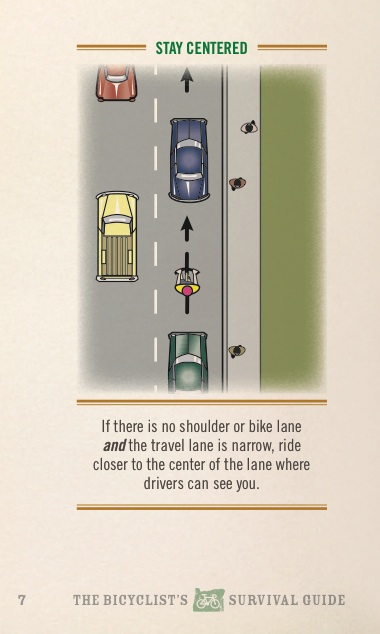
There’s also this catchy “Check yourself before you wreck yourself” diagram:
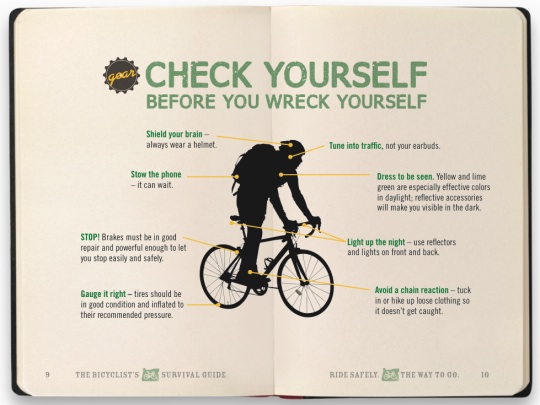
Another special section gives tips on rural road riding. The tips include:
- Watch your back with rear-view mirrors. And frequent shoulder checks can be a life-saver – especially prior to cresting a hill or entering a curve.
- Watch for critters (including unleashed dogs!) in wooded areas and farming communities.
- Think fast! Some motorists simply can’t resist going fast on open country roads, and may not expect bicyclists on the roadway. So watch out and keep your cool.
While much of the tips and the graphics/layout are solid, the messaging and title are unfortunate. Riding a bike isn’t about being part of any “crowd” and they forgot to mention that bicycling isn’t just about being thrifty, healthy or eco-friendly — for many short trips it’s simply an efficient way to get from A to B. Bicycling also isn’t dangerous and the “survival guide” framing sends the wrong message. (It reminds me of a book I reviewed back in 2011: the The Urban Cyclists Survival Guide.)
There’s also a tendency in the copy to make it seem like people are just helpless with their dangerous driving:
Drivers pulling into traffic look only in the direction of oncoming cars. If you ride against traffic, drivers won’t see you until they are on top of you…literally.
when you are riding past parked cars, keep an eye on those car doors – they have a way of swinging open quickly and unexpectedly.
telegraph your every move with hand signals. The last thing you want to do is catch a driver by surprise… the surprise may be on you!
You can download a PDF of this guide and see more from ODOT on their Bicyclist Safety website.


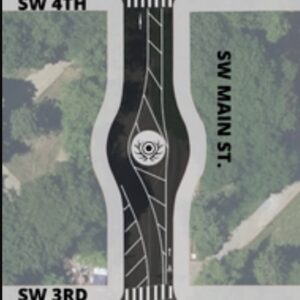
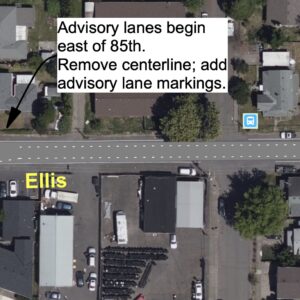
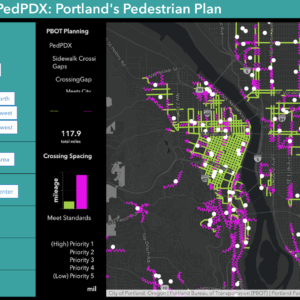
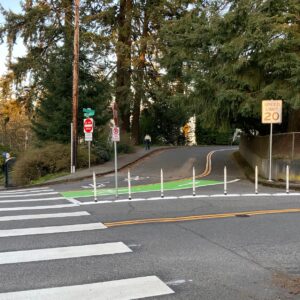
Thanks for reading.
BikePortland has served this community with independent community journalism since 2005. We rely on subscriptions from readers like you to survive. Your financial support is vital in keeping this valuable resource alive and well.
Please subscribe today to strengthen and expand our work.
If putting helmets on each rider in these images weren’t detrimental enough, ODOT’s guide absurdly warns against riding at night at all in rural areas. This is actually worse than the BTA.
Outside of occasionally being passed a little too closely by fast traffic, rural riding tends to feel much safer, and by far more fun, than urban riding to me. Sucks that it takes an hour of riding just to get to the far edge of Gresham where the nice farm roads start.
So predictable of our highway department. I’m glad they’re trying, but they really need to try harder if they want to stop looking so clueless. The “survival guide” title alone is extremely cringe-worthy. They’re never going to increase bicycle mode share with that kind of marketing.
My reaction, too. Don’t they have a Bicycle Advisory Committee to vet publications like this?
ODOT: I’m pleased you are trying, but what I don’t need is more handbooks. What I do need is better infrastructure, so that I don’t have to try and “survive” just because I’m going somewhere.
I agree, glad they’re trying but… SURVIVAL GUIDE? Seriously? People are already scared enough to ride on the streets.
Maybe they could do some “bike Rodeos” to kick this whole thing off!
As Archer would say: “Phrasing!”
I’m going to suggest they use a new title: “How to survive the nearly inevitable crushing, mangling and flattening from the cars of oblivious drivers.”
ODOT Presents: A Government Guide to Avoiding Law-Breaking Motorists.
…
it opens with this lie as their first point: Drivers pulling into traffic look only in the direction of oncoming cars.
generally when something has an obvious lie as its intro point I just dismiss the entire thing instead of wasting my time…
then their thirst point (second tip): Pedal by the book. When on the road, your bike is a vehicle. That means you have the same rights – and responsibilities – as motorists.
another lie, not as obvious… bikes and motor-vehicles have MANY, not all, of the same rights and responsibilities… this is a MAJOR problem with the way the public sees bicycles, as having to obey all the same rules because we have the same rights…
I forced myself to turn the page: Keep to the right, but not so far to the right that you risk hitting the curb or leaving the paved road. And when you are riding past parked cars, keep an eye on those car doors – they have a way of swinging open quickly and unexpectedly.
so keep far enough right to avoid curbs and unpaved shoulders, but not doors? keep an eye on doors, but don’t stay out of their path?
Check yourself before you wreck yourself? helmet, earbuds, and bright clothing have nothing to do with causing yourself to wreck… those things might help to prevent something else from crashing into you though…
When close to an intersection, never pass vehicles on the right – it’s a sure way to a knockout. Watch the right-turn signals and hang back until the coast is clear.
this bit of advice seems to show bikes in a bike lane where it’s perfectly legal to pass on the right… it seems like they’re saying that we should confuse drivers by coming to a stop in our lane for no reason while they’re waiting for us to pass them in our lane…
Be Visible, Be Alert. bright colors don’t really help at night… Steer clear of danger? just by watching vehicles? or are they suggesting that we take evasive action if there’s a vehicle waiting to cross at a stop sign? again, do they want us to stop for no reason and confuse the motorists?
Reflective tape on your sleeves or gloves will
ensure that your every move is seen by drivers… no, no it won’t… but it helps… you can’t just throw on reflective tape and then assume everybody sees you… oh, on the next page they reverse course… Don’t take it for granted: Even if you’re doing
everything right, drivers may not see you…
Plan your trip to make sure your entire route is bike-friendly
and within your endurance limits. what do they mean by bike-friendly? every road is bike-friendly… it’s the motoring public that you have to watch out for…
Be predictable: Ride in a straight line, no swerving or weaving, and use clear hand signals. I read somewhere that cyclists who swerve and weave are given more room on the road…
and I’m just embarrassed that they have to include these two:
* Watch your back with rear-view mirrors. And frequent shoulder checks can be a life-saver – especially prior to cresting a hill or entering a curve.
* Think fast! Some motorists simply can’t resist going fast on open country roads, and may not expect bicyclists on the roadway. So watch out and keep your cool.
* Don’t be left in the dark. Finish your ride before nightfall – rural roads lack the ambient light of urban areas, so drivers may not see you until it’s too late.
If that’s outside your comfort zone, dismount and walk your bike until you feel it’s safe to ride again. hopefully crossing the street to walk against traffic is also in your comfort zone…
…
on a whole this “guide” is a huge failure… a few very basic (and sometimes obvious) helpful tips mixed in with a whole lot of “watch out for motorists” rhetoric…
I wonder how much money this thing cost them to put out…
Also, the shoulder is not the road. Paved or not.
Nice review, Spiffy.
“I wonder how much money this thing cost them to put out…”
Um, that would be how much of our money it cost to put out…
But what really irks me, and I’ve noted this before, is the paternalism that seems to *always* shape what ODOT has to say about biking; whether it is riding over McKenzie Pass, or their bright clothing campaigns, or this unfortunately framed publication. Why is it so hard?! Biking isn’t just for kids. No need to talk down to us.
The irony of these comments is flooring… Literally one story above this one on the front page is of a man being killed riding a bike. Bicycling IS A SURVIVAL GAME! Do you think that by suggesting that riders not where helmets that it somehow makes it safer because of the “message”. If bicycle community all consensually advocated for not wearing helmets, they would be perceived is irresponsible and insensitive by the larger community.
I agree, ODOT should be focused on providing infrastructure to make cycling safter, but don’t play dumb by suggesting that they not address the safety hazards of cyclist becuase you think it “frames” the argument poorly. Ignoring it or pretending it’s something it’s not would be far worse…
Paul,
Many more people are killed and injured each as passengers and drivers of cars than as riders of bicycles. In 2011 for instance, ODOT’s own statistics show that in 2011, a whopping 95% of the 35,000 injury collisions involved someone in a car. And of the over 49,000 total collisions, only 1.9% involved someone on a bicycle.
Given the stats and the reality, the carnage and danger is happening to people driving, not bicycling… Yet this type of marketing pushes a fear/danger narrative that is way out of balance with reality and it’s a byproduct of internal/personal biases/preferences of ODOT staff and culture.
Well said Jonathan.
That statement isn’t really meaningful given how many more vehicle miles are traveled by cars compared to bikes. If this was a death / injury rate per VMT, the comparison would be much more informative. I’m guessing that bikes make up less than 2% of traffic / VMT — if that’s the case, the injury rate is actually higher for cyclists than for motorists / car passengers.
Which would be more accurate to use: VMT, or time traveling?
Good point! I see that as kind of a philosophical question, but either one would be preferable to the raw percentages. VMT is likely easier to measure and generate statistics for. Time traveling may be a more apples to apples measure (“For every hour you’re exposed to traffic in a car / on a bicycle, what are the chances of being involved in a collision?”)
As far as accuracy, VMT, time spent traveling, and Jonathan’s initial statement would all be “accurate.” Hence Mark Twain’s observation about “lies, damn lies, and statistics.” Even accurate statistics can be misleading.
Time… or even “time of day”? I suspect driving (or biking) during rush hours is much more dangerous (for both modes).
People who use a bicycle as primary form of transport ride afar fewer miles than the average car user. Comparing VMT between modes must factor this in. I don’t have a car, and I probably only do about 3-4k miles a year, as opposed to the 15k (!) that the average American drives. Bicyclists are just more stingy with distances, as a practical matter. Add in the number of miles that the average American is a passenger in a car, and you’ll find that your exposure to death and injury is indeed greater in a car. Yet we don’t require helmets for their use, nor do we much care about the chronic unsafe behavior of the average driver, other than the perfunctory drunk-driving PSAs.
VMT stats show that bicycling is much safer than driving…
Got a link? I’ve been wondering if these numbers existed for a while now.
I seem to remember these statistics explored in the book “Pedal Power”, and while the sheer numbers of auto fatalities/injuries are certainly much higher than in biking, when compared to the number of people who bike versus drive biking is actually slightly more dangerous. At first this makes sense to me owing how ‘safe’ automobiles (features) have become, but I would argue the bicycling numbers may have widescale reporting and tracking issues (i.e. not done systematically by modernized insurance agencies with financial incentive to track such statistics). One thing I’ve seen is that people who don’t cycle tend to believe it’s crazy-dangerous; that the likelihood of being hit and killed by a car is high. What I’ve observed instead is that cyclists tend to be very good at avoiding being hit by cars (the whole self-preservation thing), yet not always so good at bike handling or avoiding mechanical or rain/ice issues. (My girlfriend runs an ER with several nurses who bike and race and we’ve talked about this – and yes, I met her on duty after breaking my collarbone hitting a poorly-placed slippery metal grate on a bike path).
You may want to double-check me on this; my copy of the book isn’t with me right now.
I’d watch for automotive turn signals, if they were actually being used. I might even slow down in the bike lane if the cars up near the front of the queue were signalling. It would be NICE if vehicle operators got this same sort of attention/education.
Agreed. Driving is treated as free ‘n’ easy, nice ‘n’ breezy. It’s cyclists who are putting our lives into our hands. Can’t help what motorists do! Why why why can’t there be more educational campaigns and public accountability for driving behavior?
Alan Durning would say: carhead.
Although the phrase is a bit clunky I think he’s right. Those who write these silly pamphlets, by and large, drive when they want to go somewhere. Their peers also drive. Consequently they think of bicycling as discretionary, as something people do for fun, or kids do, and, like Huckaby, they assume because we do this rarely we don’t know anything and must be invited to real lists of silly actions that will help us not get run over. Ha.
I watch for any indication people driving may be about to turn, whether their turn signals are on or not. Also, if at all possible, I don’t allow myself on a bike to be abreast of a motor vehicle within turning distance of an intersection or driveway.
It’s funny to me the instinct you develop after cycling with traffic for a while. I can’t tell you how many times I’m at speed and just know who’s going to end up turning (without signaling or looking) up ahead of me. Knock on wood, of course, but the concept of instinct is just fascinating to me, as it has literally saved my life more than once, and I can’t even begin to think how to put any of it in writing. Time In The Saddle I guess.
i have experienced what you describe as “instinct,” but sometimes i think what is really going on is i always anticipate any motorist might turn without signaling, and sometimes they do.
On page 39:
“Biking down Barbur? Our bad. Just take Macadam. Whoops! We mean Terwilliger! Yeah, Terwilliger!”
That page about avoiding right hooks is particularly bad. The last thing we need is confusion over who has the legal right of way at intersections. I’m surprised (or actually…maybe I’m not) that ODOT bumbled this one so poorly.
do you want the legal right of way or do you want to avoid a right hook
The stat that there are more accidents that involve only drivers and/or passengers needs to be framed properly: there are simply more drivers than there are riders. And we can’t dispute the fact that state agencies have talked ad nauseum about dangers of DUII, speeding, texting and other reckless driving behaviors. It’s not like bicyclists are singled out!
I am pretty new to riding, and still unsure about riding on the street. I don’t know the laws very well, and frankly I don’t trust that drivers know them either. Yes, a lot of it is common sense, but certain things aren’t. This guide doesn’t take long to read, easy to remember and gives us newbies basic pointers.
And let’s be honest here: all of us witnessed bone-headed behavior by BOTH drivers and bicyclists, so plenty of blame to go around. But here’s the difference: if a driver does something stupid around a rider, the worst that happens is they need a paint job. If a bicyclist violates – well, the stakes are much higher.
Share the road, people, share the road – why so much animosity?!
even if you compare it by the number of miles via mode then bicycling is still safer than driving the same distance…
oh, but bicyclists should be singled out, because those behaviours aren’t very reckless on a bicycle due to it’s inability to make itself into a decent weapon… yet we’re not excluded from many laws that were passed due to driver negligence…
if a driver does something stupid the worst that is likely to happen is that people are dead, and likely lots of property damage… if a cyclist does something stupid the worst that is likely to happen is broken bones…
…
but yes, the guide does give some decent basics, but it’s not sending a good message, and that’s what everyone is complaining about…
if a driver does something stupid the worst that is likely to happen is that people are dead, and likely lots of property damage… if a cyclist does something stupid the worst that is likely to happen is broken bones…
You are correct… I should have said “the worst that happens to THEM is they need a paint job”. But we humans are naive and simply don’t believe we can possibly endanger anyone. Perhaps not naive – it’s just that none of us could bear the thought that we are “evil” in any way, so we deflect responsibility more often than not…
oh, but bicyclists should be singled out, because those behaviours aren’t very reckless on a bicycle due to it’s inability to make itself into a decent weapon… yet we’re not excluded from many laws that were passed due to driver negligence…
You misunderstood my statement: I meant that there are plenty of messages to drivers, too – not just riders. It is true that bikers are infinitely less dangerous to others than drivers – no question about that. But why would we condemn ODOT for trying to enhance the safety of ALL citizens from death and injury?! Any death and injury – driver, passenger, pedestrian, rider – bears colossal cost to family and society. It’s naive and selfish to say “the only one who suffers is me”
This is the transportation equivalent to the “Watch those short skirts, ladies!” Kind of advice that excuses male behavior. Disgusting that it comes from a government agency.
Silly… I, for one, am not willing to trust my safety to drivers who may be preoccupied, hurried, distracted, overwhelmed, have poor eyesight or forgetful. I don’t believe motorists are out to “get” riders – it’s just we are all mindless at one time or another. Are you saying we should expect 100% compliance and complete ABSENCE OF MISTAKES from ALL drivers? That will be the day! In the meantime, I will assume drivers don’t see me and ride defensively. Although it still scares the daylights out of me to ride on the road.
Not really much of a fan of much in the “guide”. The title is terrible – might as well be “Be affraid, be very affraid”
VMT stats put cycling as a much safer mode of transport than driving. Infact if I’m not mistaken VMT stats put biking safer than walking.
I’m just really tired of all the “safety” BS. Mostly the helmet stuff but the bright color/reflective gear garbage as well.
It been known for awhile now that in areas with manditory helmet laws that :
1) the amount of fewer deaths related to bicycle accidents doesn’t make up for the additional risk to the riders who choose to continue riding after such laws are inacted. Since manditory laws reduce ridership by roughly 33% (1/3 drop in ridership is pretty consistant in all communities world wide) a rider is actually more at risk to be involved in a deadly crash.
2) Non leathal head injuries dramatically increase under manditory helmet laws.
3)There is only one proven way to reduce bicyle injuries and deaths, and that is increased ridership.
Now none of the above is much of a surprise to anyone that’s looked at the facts and figures or followed the issue for awhile. It’s not even close to new news. However, what I recently found shocking is that the nearly everyone in the helmet industry doesn’t even really care as told in the article linked a few weeks back in Bicycling (http://www.bicycling.com/senseless/).
I don’t know why this topic isn’t more debated. It’s definately more important to cycling and its future than another dumb jock on “roids” or the asthetics of bike share racks.
As for the bright clothing and reflective gear a simple leason in the arrangement of the rods and cones in your eyes should point out the faulty logic behind these ideas. The fact is that color is detected less and less the further an object is from the center of vision. So unless someone is looking nearly directly at you the effect of bright colors is nearly mute. This is why at night you can actually see better if you look slightly over ther road than down at the road when riding or driving. Your color blind rods are better suited for low light conditions. While the cones which see color best, are clustered more at the center of the retna.
Same goes with reflective products, if you’re not in the head lights they do you no good. No good for dooring, right or left hooks, or even people not paying attention.
But all this safe stuff is great for industry. Millions of dollars a year for lids that really don’t protect, which might actually cause more injuries. And boat loads of cheap plastic cloth to an unsuspecting and lazy consumer. Heck its an extra $100 add on sale when you’re leaving the show room floor.
Now if you really want to make cycling safer, just ride. And ride more often. Preferablly without a helmet. But wear one if it makes you feel better (I won’t say a word honestly) Seeing riders with helmets and the constant warnings discourages others from riding. Doesn’t matter if the reasons are from don’t wanting to mess up their hair to the perception that it is a dangerous activity, all of us need them on pedals.
“…Bicycling also isn’t dangerous and the “survival guide” framing sends the wrong message. …” maus/bikeportland
It seems much of what’s reported or written about in articles here at bikeportland by the weblog’s writer-editor-publisher, repeatedly stresses how dangerous bicycling is because of motor vehicles on the road.
That biking on roads and streets with motor vehicles holds elements of danger…and that there are various practices cyclists can follow to mitigate that danger, is what ODOT’s new handbook seeks to convey to those reading the handbook. I’m personally not a big fan of rhyming adages like some the writers of this handbook have used, but those kinds of phrases can sometimes make it easier for people reading to understand and remember the message.
The ‘Avoid The Right Hook’ graphic on pg 3 of the guide does a good job of showing exactly how…to minimize the chances of a right hook occurring…a cyclist riding in a bike lane and to the right of motor vehicles as both approach an intersection, should position themselves relative to the motor vehicle.
Pg 4 of the handbook: I think the graphic advising cyclists to try hold their lower arm at a 90 degree angle to their lower arm as a signal for a stop, is bad. A 45 degree downward angle is better: easier position to hold, and puts the hand further out making the signal more visible to road users.
Also not so good on Pg 4: “…Reflective tape on your sleeves or gloves will ensure that your every move is seen by drivers–especially at dusk and at nighttime. …”
Ensure? That’s overconfidence. Reflective tape will hopefully help drivers to see vulnerable road users…but it’s no guarantee they will see.
Prominent on Pg 1, this is good:
“Pedal by the book. When on the road, your bike is a vehicle. That means you have the same rights – and responsibilities – as motorists. So obey all traffic signs, signals, lane markings and other rules of the road.”
…as is the link on the last page of the PDF, to Oregon’s pedestrian and bike laws. Maybe that link would have been more effective on Pg 1 of the guide directly beneath the statement about cyclists’ rights and responsibilities.
Uggh, “Survival Guide” just perpetuates the notion that riding a bike is something only the irrational and careless do– that I’m choosing to put my own life at risk.
I think that a lot of these comments deriding the booklet (and I haven’t read them all, so there may be exceptions) are mainly just nitpicking and ignore the broader, more relevant point: offering some good points for riders to be prepared, be seen, be safe, have fun in a brief handout. And remember that is this booklet is likely aimed towards newer or more inexperienced riders who might need some broader advice on how to ride safely.
Indeed, there are some good points: ride WITH traffic instead of opposed; use hand singals; stay out of blind spots; take the lane when needed; wear bright and reflective clothing (yes, bright clothing can help at night as well, such as when illuminated by a street lap, headlights, or another biker’s lights).
There may be some legitimate issues (the notion of drivers “never” looking to check the lane against the flow of traffic for pedestrians is a good complaint). But what are people mostly complaining about here that makes this booklet “a huge failure” (in the words of one poster)? The titling of the booklet as a survival guide? Given that AAA has published a driver’s survival guide and “survival tips” when traveling, and that we have “survival guides” for everything these days (including a zombie apocalypse), I don’t see this as a real issue; rather, it’s just a way for the booklet to catch someone’s eye and interest. Many of the other comments complaining about how bright clothing won’t save you, or taking issue with the common phrase “Check yourself before you wreck yourself” again miss the booklet’s broader point. And as for the comment that the booklet is the government’s equivalent of perpetuating sexism, but against cyclists (huh?), I don’t even know where to begin with that.
I’m not going to dissect every comment here, but it seems like the general gut reaction is to find fault and either (1) profess how this booklet is a joke and a waste of time and money; or (2) shake our heads and chuckle about how out-of-date, narrow-minded and behind the times ODOT is, but to laugh to ourselves and say, “welp, they’re trying.” Let’s try and keep some perspective. This is ODOT, putting out a small booklet, offering helpful advice for cyclists to ride smart and safe. Let’s not jump down ODOT’s throat because they didn’t make the perfect manual. Let not ridicule just for the sake of gainsaying. And let’s not deride them for the book they didn’t publish, but rather see the fact that they did put out something helpful.
I know many of these rules. I follow a lot of them. This booklet wasn’t aimed towards me. But I still like it and I’m still happy they published it.
Right on Bry! While I agree the title could have been less fatalistic, actually having a publication detail the practicalities of riding with traffic in the real world is fantastic, and I actually like the copy that Jonathan points out – it’s a pretty realistic description of the consequences of seemingly simple mistakes. I see people nearly get hit daily by riding (and walking) on sidewalks in the opposite direction of traffic – drivers always look to the left as they pull out, and a very high percentage either never look right or only after they’ve crossed the sidewalk and are pulling into the street.
A publication actually telling cyclists to center themselves when taking the lane… simple, yet brilliant! Just say no to gutter trawling.
Umm, sorry to not overreact about a title, but “Survival Guide” is a cliche. A little less herp and a bit more derp…
…Stay tuned next week when our valiant Editor-in-Chief, Spiffy, and his merry Wordsmithers – Hart Noecker, Nick, Art Fuldodger, Ayleen, Oliver, 9watts, David, peejay, gutterbunnybikes and pdxpaul – provide us all a draft copy of what a real reference handbook for beginning cyclists should look like… BTW, donations are now being accepted to improve Oregon’s cycling and multi-modal infrastructure due to projected gas tax revenues falling 25-30 short largely due to the recent Hybrid Invasion, increased fuel efficiency and…(please take a seat)…increased bicycle ridership. Please send contributions to http://www.infrastructure_isnt_free_maybe_phil_knight_can_help.com
I have myself (partially) to blame. I commute by bike, I drive a car AND I work for ODOT.
Speaking of education, I know another piece of public education long overdue. There are over 4500 employees that work for ODOT, and I think less than 5 hold a job that is specifically and solely responsible for developing multi-modal informational and safety-related documents to raise public awareness, help out new non-motorists and make the infrastructure we all currently share just a little bit safer. There might be another dozen that help these folks out when they can. Do we have a BAC?!(giggle). No. And we don’t each have a private secretary or bottled water service or someone to empty our waste baskets or company smartphones or permission to travel all the way to Vancouver, WA for a training class without a permission slip from the Director of the Department, either. But, we try our best…and I will continue to do so, despite the comments I read today.
Jonathan, thanks for the opportunity to comment.
Thanks for helping us understand how marginalized and understaffed ODOT’s multimodal info division is.
But can you help us understand where the paternalist tone comes from? Why does it sneak into every piece of information or PSA of ODOT’s that has to do with biking?
“…But what really irks me, and I’ve noted this before, is the paternalism that seems to *always* shape what ODOT has to say about biking; whether it is riding over McKenzie Pass, or their bright clothing campaigns, or this unfortunately framed publication. Why is it so hard?! Biking isn’t just for kids. No need to talk down to us. ” 9watts
Some of the people biking, definitely are kids, and if not kids, very possibly are people older than kids, that aren’t yet well familiar with standard procedures for riding in traffic, or experienced in riding a bike on roads and streets along with motor vehicles.
This handbook likely has been produced with these types of riders in mind, and most likely wasn’t directed towards people riding that already have plenty of skill and ability in riding a bike amongst motor vehicle traffic.
There were a few things about the new handbook, I didn’t think were as good as they could have been, but on the whole, it seems like a fairly good effort that a lot of people are going to enjoy for its lighter tone, and appreciate for the mostly helpful information it offers.
wsbob – please.
That fellow Huckaby wanted those who bike to learn what was in the DMV handbook too. Then it turned out that he – who very much had a license, had presumably studied said manual, passed all proficiency tests, etc. – was a serial offender when it came to following those rules in the DMV handbook: http://bikeportland.org/2012/09/05/bob-huckaby-moves-forward-on-statewide-bike-registration-licensing-measures-76881#comment-3200315
What gives?! Why save the paternalism only for those who bike when we know full well, have had occasion to learn right here on Bikeportland over and over and over, that traffic in/competence is rather evenly distributed across modes?
“Some of the people biking, definitely are kids, and if not kids, very possibly are people older than kids, that aren’t yet well familiar with standard procedures for riding in traffic, or experienced in riding a bike on roads and streets along with motor vehicles.”
You don’t really think this manual is written for kids, do you?
I am with you on the Huckaby fellow, (and although I have never met him I question his motivation and the timing of his concern for safety) but I need help understanding the paternalism. I have a job where I am put in a paternalistic role, and I know it is uncomfortable for people to be told that they are using poor judgement. What things has ODOT done or written here which really sort of twist the knife for you, as regards to paternalism?
I read folks here making philosophical criticisms left and right, disagreeing with the advice. I’m not surprised that helmets are advocated, for example. Realistically, if I made that booklet and wrote “The jury is out on helmets” I would expect much more backlash from the rest of the community outside of the radical bike community. And look at what a nice bunch you are. So anyway, I hope you can give me an example of how one could non-parernalistically encourage adults to wear a helmet.
how do you tell people on a boat not to drink too much beer in the sun without a life jacket… without coming off as paternalistic? You shouldn’t have to tell them. Just like bright clothing at night, no?
Thanks to the folks at ODOT who put this pamphlet out. I think the right hook advice is stellar (and the reason I’ve never had a right hook close call) and I’m pleased to know that your target market is sure to be more appreciative than “Pfffffft! This is not as good as the BTA even!” so take what you read here lightly.
“What things has ODOT done or written here which really sort of twist the knife for you, as regards to paternalism? ”
Thanks for your question. To answer it I think we need to back up a bit.
Your examples, “I know it is uncomfortable for people to be told that they are using poor judgement” illustrates what I *don’t* think ODOT should be in the business of communicating. You mentioned helmets and drinking beer in the sun without a life jacket. Why should ODOT be giving this kind of detailed advice, wagging its bureaucratic finger at people who bike? Do they wag a comparably big finger at people who drive? The kinds of suggestions that appear in the Check yourself before you wreck yourself spread is a long, tedious list, some of which may be useful coming from your riding buddy, from the guy who sells you a bike at a bike store, or from a parent who is teaching her child how to bike, but why on earth is ODOT getting into the business of communicating this sort of detail via pamphlet to the vast population of people who bike?
How would you react, or imagine others might react if ODOT published this sort of minutiae directed at those who drive cars, a CARist’s SURVIVAL GUIDE? Check yourself before you wreck yourself? Can you imagine that sort of sing-song rhyme, with its implied assignment of fault, directed at adults who drive cars coming from a state agency?
…The pamphlet then goes on to detail half a dozen categories of things you are/are not supposed to do. Fasten your seatbelt; don’t eat or apply makeup while driving; wear bright clothing so people outside the car can see you through your tinted windows; protect your vital organs by wearing a ____….. It is insulting, and unless you can point me to a parallel pamphlet by ODOT directed at those who drive I rest my case. And I checked, the word ‘survival’ does not appear in the current edition of the Oregon Driver Manual.
Interestingly, ODOT has published a Survival Guide for Pedestrians (2012). http://library.state.or.us/repository/2012/201210311026343/
http://www.oregon.gov/ODOT/TS/Pages/SafeandCourteousDriving.aspx
Yes, I do think the new ODOT handbook was written, not just for ‘kids’, but certainly with ‘kids’ in mind as well as adults. The only age ‘kids’ the book,understandably, wouldn’t have been written for, I think, would be those say…10 yrs old and under, whose parents, hopefully aren’t allowing them to do a lot of riding out in traffic by themselves.
The word ‘kids’ is one of those words people commonly use to convey a wide range of meaning not confined to only describing people whose chronological age makes them children. In your original post closer to the top, you didn’t offer a specific chronological age range to explain what you meant by your use of the word ‘kids’.
About Huckaby:
“He told me today he’s had three speeding tickets. He’s not trying to hide anything. He sped. He got tickets. He paid them.” maus/bikeportland
You seem to feel someone of middle age, having received three speeding tickets over what may have been four or five decades of driving, makes them a serial offender.
I think many people in Oregon share a sense that people anticipating spending a fair amount of time riding a bike in traffic amongst motor vehicles, should have some well grounded, standardized, officially recognized knowledge of how to effectively ride in traffic for safe, efficient travel for themselves and other road users. Long time cyclists with many hours of experience on their bikes in traffic amongst motor vehicles likely already have acquired this knowledge; but there most likely are many other people thinking about riding, or that haven’t ridden in traffic much, that don’t have this knowledge.
By itself, this handbook isn’t sufficiently detailed to serve that purpose, but it does touch on some things many people riding may benefit from knowing.
Since I was namechecked here, I should say that you clearly failed to understand my comment. By stating that the title is cliche, I was saying that I felt there was overreaction in the comments over the title.
That said, drop me an advance payment and I would gladly get something started. JM has my email address.
Condescending and paternalistic.
I think that this guide is great for mitigating potential hazards in current infrastructure for the 8-80 set. If my aunt wants to start biking to the grocery store, I would hope she builds up her comfort level before biking at night in a rural area. The last thing she needs is to fall in a ditch on an unfamiliar road. Add to that: when you are new (and the target audience of a “survival guide” type pamphlet) all of the paths are unfamiliar at first. No, I wouldn’t follow this brochure’s advice dogmatically, but I am like that with most 20 page-or-less brochures.
This is the stupidest thing ever. Who gave them input on this specific publication?
Is this produced as a pamphlet or just buried on their website (which was down earlier)? I feel that there is a bit less talking down going on here than with the pedestrian and bike SURVIVAL guides, but I see some parallels and appreciate you finding this.
Curious.
We are further from reaching ODOT’s own goal today than we were when it was formulated:
“Reduce bicyclists killed and injured in motor vehicle crashes from 708, the 5 year average from 2003 to 2007 to 555, a 3 % reduction per year by 2015”.
http://www.oregon.gov/odot/ts/Pages/bicyclistsafety.aspx
Not only that, they’ve stopped updating the (embarrassing) stats. Here are the missing ones. Not sure when the 2014 numbers will be posted.
1,064 injured pedalcyclists (+10.6%) in 2012
957 injured pedalcyclists in 2013
From here: http://www.oregon.gov/ODOT/TD/TDATA/pages/car/CAR_Publications.aspx
for an average year-over-year increase of 6.6% since 2007.